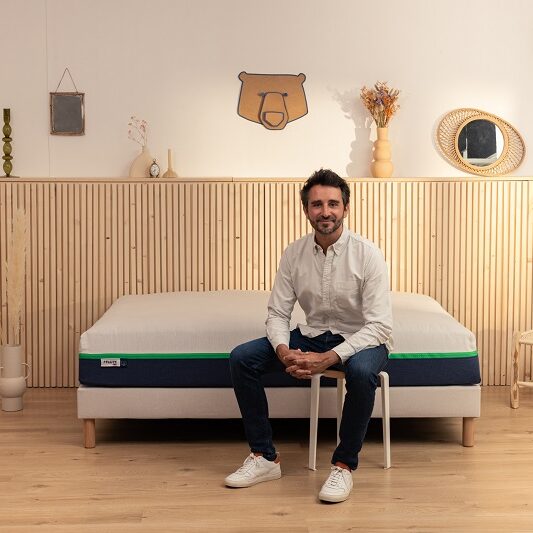What do a mattress startup and a medical resources platform have in common? The answer: listening, learning and adapting their prototypes after striking their million-dollar idea. We spoke to Tediber founder Julien Sylvain and Hopia co-founder Victoire Bach to find out how they refined and perfected their business idea – with a little help from their customers (and competitors!)
You both hail from very different industries (Tediber is a startup selling mattresses, while Hopia is a scheduling tool aimed at healthcare professionals). Can you share a little bit about what drove you to push forward with your idea?
Julien: “I had already launched a couple of different startup ideas but nothing had stuck. I really enjoyed collaborating with a designer I had met during my time at ESCP’s Blue Factory, and we worked off of a really simple premise. We wanted to create a strong, digital-first brand, and we realised that nobody we knew could tell us the brand of mattress they slept on – despite it being more important than their car, their shoes, or their favourite coffee. We quickly saw the potential for a streamlined, digital-native brand in the space.”
Victoire: “I had always wanted to pursue a project that was meaningful while concretely helping people, and like Julian, I was fortunate enough to have a team of people who inspired me to take my idea further.
Hopia was born just before COVID, with the aim of helping hospitals to better manage their resources. The platform allows healthcare professionals to correctly staff shifts, getting the right people with the right expertise to the right places while making sure that legal requirements, such as breaks and shadowing, are fulfilled.”
The best feedback we got was actually from other manufacturers, who more or less showed us the direction to take in terms of what not to do.
Julien Sylvain

What did your first prototype look like? Who did you show it to?
Julien: “As I learned at the Blue Factory, the prototype is just the means by which you test your hypothesis. Before actually creating the first product prototype, we needed to know if we could make a high-quality product, transparently and simply, at a fair price. The best feedback we got was actually from other manufacturers, who more or less showed us the direction to take in terms of what not to do. The majority of products in the space seemed overpriced and were marketed far too scientifically. Of course, we prototyped actual products countless times, but the idea I tested using that first prototype held true and still informs the way we work. Today, we’ve expanded from one mattress to four, but we’ve kept that streamlined approach.”
Victoire: “Our first prototype was an Excel spreadsheet, which confirmed what we wanted to test – that a digital tool can, if given the right information, attribute staff members, surgeons and other key personnel as accurately as a human can. Our users confirmed our hypothesis almost instantly. We always knew that the time-saving potential of Hopia was huge, but the spreadsheet got us on the right track and it gave us something visible to pitch to our clients. That’s when I knew that Hopia was a good idea worth developing.”
Did you find your initial feedback easy to work with?
Julien: “We obviously got lots of feedback about the mattress itself – some people loved it, some people didn’t – but we made a conscious decision to listen as much as we could while being careful with our resources. Even today, we only have four boutiques across France and a product range that’s almost as small as when we started. This allowed us to take risks in other ways, such as offering our customers a 100-night no-questions trial. That choice shows belief in our product, which is super important for us. We’re not getting repeat customers every six months.”
Victoire: “Yes, very much so, for the simple reason that, while we continued to champion our initial premise, we allowed ourselves to be led by our users when it came to developing the software. We were always clear about the problem we were aiming to solve, but we’re not health experts and we’re not out to market to a huge customer base – our users are our biggest critics and our biggest champions, which is uniquely helpful.”
By regularly, methodically asking our users what works and what doesn’t, we’ve not only ensured that Hopia is an on-target product but it saves us huge amounts of time and back-and-forth.
Victoire Bach

Read on for Victoire and Julien’s top 3 tips for refining your business idea.
Rule #1: When in doubt, ask, ask, and ask again
Julien: “I realised early on in the process that I was going to have to stand out with Tediber, so I made a conscious choice to spend as much time with industry pros as possible. I was a newcomer to the mattress industry, but after I gleaned as much information as I could about how existing brands viewed their products – and their customers – I had what I needed in order to apply my digital skills.”
Victoire: “We have a great tech team and fabulous UX designers at Hopia, but we’re completely driven by our clients’ needs – in our industry, it can’t be otherwise! By regularly, methodically asking our users what works and what doesn’t, we’ve not only ensured that Hopia is an on-target product but it saves us huge amounts of time and back-and-forth. This, in turn, saves us money and lets us spend more time developing new features.”
Rule #2: All feedback is useful
Julien: “We still receive a lot of feedback about our mattresses, some of which helped us to make the choice to move away from latex early on in the business. We could have made that [listening to feedback] less of a priority, but sometimes the least obvious comments hold the biggest indicators of change. Today, I’m really proud that we made that environmentally-friendly choice when we could have passed it by.”
Victoire: “I’d second that. As a concrete example, we once received a piece of what we thought was minor feedback from a client, who really pushed for us to add a small tracking widget to the app. We eventually implemented it and were inundated with positive feedback. The lesson: your ‘nice-to-have’ could be a real essential for your customer.”
And the golden rule:
Julien: “It’s never too early to get started! My main piece of advice would be to get out and show your product to your customer as quickly as you can.”
Victoire: “Make your own rules for success. It’s important not to get caught up in KPIs and classic measurement tools – try and measure each stage of your product’s development individually. Is it leading you towards your goal? Are you still keeping the customer top of mind, and are you still solving a key problem?”
License and Republishing
The Choice - Republishing rules
We publish under a Creative Commons license with the following characteristics Attribution/Sharealike.
- You may not make any changes to the articles published on our site, except for dates, locations (according to the news, if necessary), and your editorial policy. The content must be reproduced and represented by the licensee as published by The Choice, without any cuts, additions, insertions, reductions, alterations or any other modifications.If changes are planned in the text, they must be made in agreement with the author before publication.
- Please make sure to cite the authors of the articles, ideally at the beginning of your republication.
- It is mandatory to cite The Choice and include a link to its homepage or the URL of thearticle. Insertion of The Choice’s logo is highly recommended.
- The sale of our articles in a separate way, in their entirety or in extracts, is not allowed , but you can publish them on pages including advertisements.
- Please request permission before republishing any of the images or pictures contained in our articles. Some of them are not available for republishing without authorization and payment. Please check the terms available in the image caption. However, it is possible to remove images or pictures used by The Choice or replace them with your own.
- Systematic and/or complete republication of the articles and content available on The Choice is prohibited.
- Republishing The Choice articles on a site whose access is entirely available by payment or by subscription is prohibited.
- For websites where access to digital content is restricted by a paywall, republication of The Choice articles, in their entirety, must be on the open access portion of those sites.
- The Choice reserves the right to enter into separate written agreements for the republication of its articles, under the non-exclusive Creative Commons licenses and with the permission of the authors. Please contact The Choice if you are interested at contact@the-choice.org.
Individual cases
Extracts: It is recommended that after republishing the first few lines or a paragraph of an article, you indicate "The entire article is available on ESCP’s media, The Choice" with a link to the article.
Citations: Citations of articles written by authors from The Choice should include a link to the URL of the authors’ article.
Translations: Translations may be considered modifications under The Choice's Creative Commons license, therefore these are not permitted without the approval of the article's author.
Modifications: Modifications are not permitted under the Creative Commons license of The Choice. However, authors may be contacted for authorization, prior to any publication, where a modification is planned. Without express consent, The Choice is not bound by any changes made to its content when republished.
Authorized connections / copyright assignment forms: Their use is not necessary as long as the republishing rules of this article are respected.
Print: The Choice articles can be republished according to the rules mentioned above, without the need to include the view counter and links in a printed version.
If you choose this option, please send an image of the republished article to The Choice team so that the author can review it.
Podcasts and videos: Videos and podcasts whose copyrights belong to The Choice are also under a Creative Commons license. Therefore, the same republishing rules apply to them.





